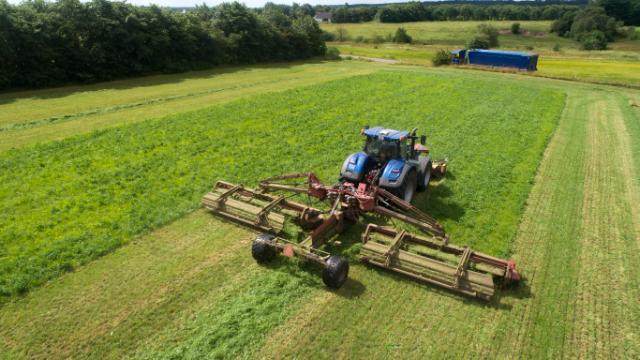
DLF Alfalfa
Alfalfa is grown in most temperate regions of the world. It thrives very well on well-drained soils with a sufficient content of lime, potash and phosphate and with its long deep tap root system it will be able to withstand severe drought. It has a high nutritional value and is very productive in with early spring growth and rapid regrowth after cutting. It can be conserved as hay but it is also possible to ensile the crop or alternatively it can be dried artificially and made into pellets. Alfalfa is divided into dormancy rates that refer to autumn growth after the last cut.
Sow Alfalfa seeds and enjoy numerous benefits
High drought tolerance, excellent yield with a high protein content and not least a natural nitrogen source. The reasons for choosing DLF Alfalfa are manyfolded.
Some things seem too good to be true. Alfalfa is one of them. Nevertheless the benefits you get from sowing alfalfa seeds are all very true:
- With its long deep tap root system alfalfa is able to withstand severe drought
- Alfalfa has a high nutritional value and is very productive with early spring growth and rapid regrowth after cutting
- Alfalfa can be conserved as hay, but it is also possible to ensile the crop or alternatively it can be dried artificially and made into pellets.
These game-changing benefits are the reason alfalfa is grown in most temperate regions of the world, where it thrives very well on well-drained soils with a sufficient content of lime, potash and phosphate.
Do you already know DLF Alfalfa?
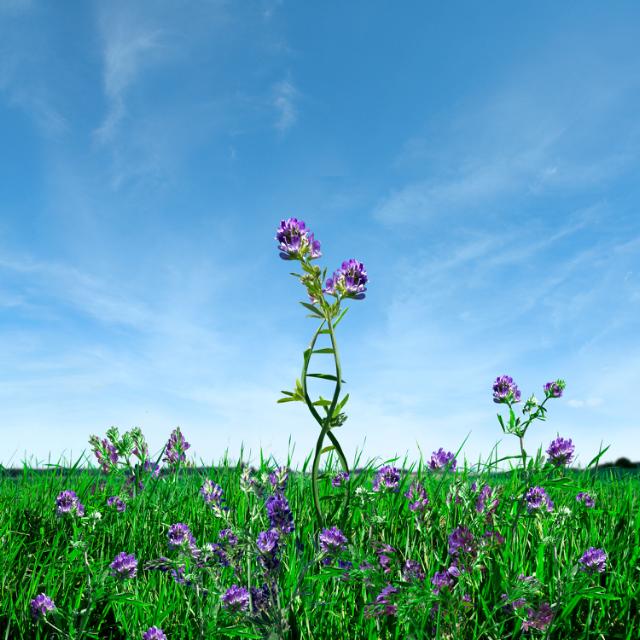
Free yourself from uncertainties from fluctuating world market prices
Up to 20% protein content in your own prodction
High-yielding farm animals that require high levels of protein perform better with DLF Alfalfa. DLF Alfalfa contains up to 20% protein, compared with 14% for grasses and 9% for maize.
DLF Alfalfa also has a very high feed-conversion rate and contain essential fibers and nutrients to improve digestion. The dry-matter protein content of DLF Alfalfa is up to 20%.
This means that alfalfa is an easy and effective way to free yourself from fluctuating market prices for other protein sources such as e.g. soybean cakes.
Nitrogen fixation
Alfalfa provides symbiotic nitrogen fixation covering the need of the alfalfa plants and companion grasses in clover-grass mixtures.
A persistent crop
DLF Alfalfa is highly cost-effective. A field of DLF Alfalfa grown for forage produces for three to five years.
Drought-tolerant
A field containing DLF Alfalfa is also a reliable source of protein during dry periods because the plant's deep tap roots continue to draw up moisture. T
DLF Alfalfa also performs at its best in combination with grass
Feed value of alfalfa-grass mixtures
A seed mixture containing DLF Alfalfa and grasses is a three in one solution:
- Improves the feed value through an optimal ratio of energy and protein
- Makes it easier to conserve as silage and exploit for grazing
- Offers more reliable feed production during dry periods
The dry-matter feed value from DLF Alfalfa-and-grass forage is 165 g protein/kg, and its energy is 0,85 UFL/kg (UFL = unité fourragère lait = milk feeding units). Pure grasses have a slightly higher energy value of 0,88 UFL/kg, but are a much lower protein source at 113 g/kg.
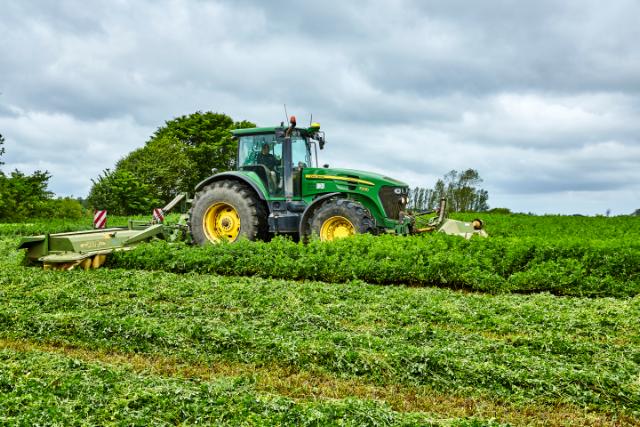
With Alfalfa-grass mixtures you get
Increased protein content
The dry-matter protein content of DLF Alfalfa is up to 20%. In grasses it is up to 14%. By mixing the two, you can increase protein content in your forage by 1-5%.
Decreased sugar content
Grasses have high dry-matter sugar levels, sugar content in DLF Alfalfa is somewhat lower. When you mix the two, you achieve a sugar content that is roughly midway between the two.
Protein self-sufficiency
The tables below show the effect on protein and energy production
by introducing 10 hectares of alfalfa into the rotation.
Source: A. Uijttewaal, Y. Carel, S. Battegay, ARVALIS-Institut du Végétal. Journées AFPF – March 2016
Autonomy with and without alfalfa for protein and energy needs
| Protein | Energy | |
| Without Alfalfa | 15% | 40% |
| With Alfalfa | 30% | 61% |
Hectares on the farm before and after introducing 10 ha alfalfa
| Hectares | Before | After |
| Alfalfa | 0 | 10 |
| Oilseed/cereals | 75 | 76 |
| Silage maize | 47 | 36 |
| Grassland | 53 | 53 |
| Total | 175 | 175 |
More milk from forage
Research carried out by DLF showed how various combinations of DLF Alfalfa and Festulolium (Festuca and Lolium types) altered the yield of dry matter, protein content, and digestibility:
| DLF Alfalfa | Festulolium Perun |
50% Perun 50% Daisy |
Festulolium Hykor |
50% Hykor 50% Daisy |
|
| Yield, Ton DM/ha | 9,5 | 14,5 | 14,4 | 13,6 | 12,7 |
| % Protein in DM | 19,7 | 11,4 | 17,9 | 11,9 | 16,8 |
| % Digestible Organic Matter | 70,0 | 74,9 | 72,9 | 70,1 | 67,0 |
Source: DLF R&D trial network
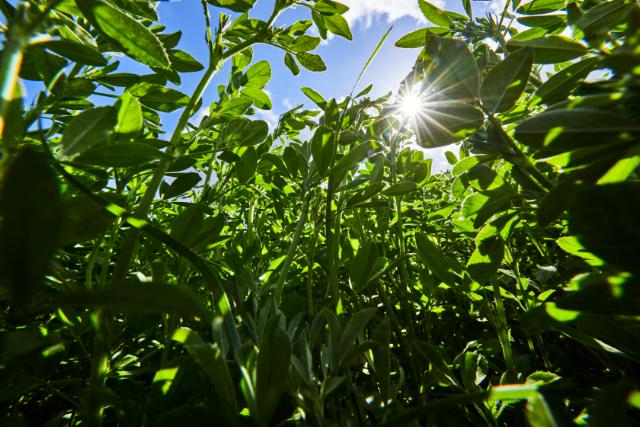
Research shows that alfalfa reduces feeding costs
Surveys undertaken in France show how the introduction of a small percentage of alfalfa cuts feeding costs. The average saving was 6€/1000L; survey results ranged from 0€ to 12€/1000 L milk.
|
Nine projects introducing alfalfa in the forage ration to reduce feeding cost Published by Institut de l’Elévage 2011 “Les réseaux d’élévage” |
|||
|---|---|---|---|
| Region of France | System | Area (and % of total) containing alfalfa | Economic impact |
| Landes | Milk+ sales crops | 5 ha (8%) | + 4 € /1000L |
| Haute Marne | Milk+ sales crops | 8,8 ha (4%) | + 12€ /1000L |
| Cher | Milk+ sales crops | 8 ha (4%) | + 10€ /1000L |
| Loiret | Milk+ sales crops | 2 ha (1%) | + 5 € /1000L |
| Indre et Loire | Milk+ sales crops | 8 ha (4%) | + 11 € /1000L |
| Nord | Milk+ sales crops | 5 ha (5%) | + 3-5 € /1000L |
| Loire- Atlantique | Specialised milk | 4,5 ha (6%) | + 0 € /1000L |
| Marne | Milk+beef+ sales crops | 17,5 ha (5%) | + 9 € /1000L |
| Mayenne | Milk+beef+ sales crops | 3,5 ha (5%) | + 6 € /1000L |
Looking for additional information?
DLF Alfalfa provides improved feeding structure and prolonged digestion for horses and vulnerable animals. The high intake by dairy cows providing higher feed conversion also makes DLF Alfalfa well suited for mixtures with grasses. For more guidance and for you to become familiar with DLF Alfalfa, we have gathered important knowledge and information in the following brochures:
DLF Alfalfa – Start growing your return today! Read now
Questions & Answers about DLF AlfalfaRead the Q&A
DLF Alfalfa – a leaflet for the farmer Read now
ForageMax brochureRead now
Silage characteristics of maize, grass, and DLF Alfalfa
Characteristics and how to improve the diet
| Feeding source | Main characteristics | How to improve the diet |
| Maize | High energy concentration (carbohydrates - mainly starch) Low protein content and cell wall content (NDF) |
Protein - soya concentrates, legumes. Fibre especially NDF- grass. DLF Alfalfa, straw |
| Perennial grass-legume mixtures | High content of fibre (NDF) and protein (legumes in particular) |
Energy-maize silage. grain concentrates Eventually more protein |
|
Medium energy concentration |
||
| DLF | Very high content of protein |
Energy - Maize silage, grain concentrates Silage additives |
|
Low energy concentration, low silage coefficient |
Grassland legumes boost milk production
Comparison of digestibility, intake, and milk production
| Digestibility, DM | 72 | 69 | 72 | 64 |
| Silage intake kg DM/cow/day | 11,4 | 12,9 | 13,2 | 13,6 |
| Kg milk/cow/day | 26,5 | 31 | 30,7 | 29,3 |
Comparison of digestibility, intake, and milk production (kg Energy Corrected Milk) per cow per day for silage made from pure ryegrass, red and white clover-and-grass mixtures, and alfalfa. Dewhurst, 2003.
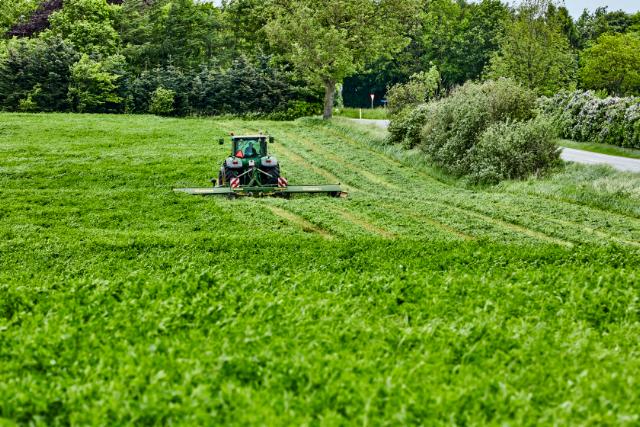
The basics of alfalfa botany
If you are thinking of introducing Alfalfa to your forage mixtures, it is helpful to know the basics of the plant's botany.
Alfalfa seed development
A germinating alfalfa seed produces a radicle followed by two cotyledons. The first true leaf is mono-foliate; the following are trifoliate. The presence in fully developed plants of multi-foliate leaves is a variety characteristic often associated with enhanced forage quality simply because the leaves provide better nutrition than the stems.
However, an eventual advantage of multi-foliate has not been demonstrated.
Dormancy
Alfalfa varieties are traditionally divided into ten fall dormancy (FD) groups. Each group corresponds to the stage during autumn when growth declines. The earlier the onset of dormancy, the lower the group number. The most dormant varieties (FD 1) cease growing very early; the least dormant (>=FD10) barely stop growing, which makes them more vulnerable to low-temperature / frost damage. As a rule of thumb, you can use the dormancy group number as a guide to the number of cuts you can take during the season: 3 cuts for FD3, 8 for FD8 etc.
Lodging and standability
Varieties that exhibit high standability (= no lodging) are much appreciated by those who want to dry their alfalfa. Harvesters can finish their harvest under good conditions with preserved feeding quality, even in the last field within a cutting cycle.
For breeders, the challenge is to develop thin-stemmed varieties for their better feed quality without compromising standability.
Rhizobium bacteria
Alfalfa is, like other leguminous crops, self-sufficient with nitrogen. The nitrogen is drawn in through the symbiotic work of Rhizobium bacteria. If you are planting in soils that lack Rhizobium bacteria, you have to inoculate the seed at the time of sowing or use a pre-inoculated.
Shoots and roots
New shoots emerge from the crown buds of. The growth is rather upright. Alfalfa has deep-growing taproots that provide drought-tolerance and rapid regrowth from stored carbohydrates.
Seed production
Alfalfa is an insect-pollinated plant, sown in the spring under a cover crop or, during summer and autumn, on bare land. Seeds can be harvested during the following two years.
DLF Alfalfa is a more reliable feed source during dry periods
With its long deep tap root system alfalfa is able to withstand severe drought. During spring and summer droughts, the dry-matter yield from grass-and-alfalfa seed mixtures can be up to four times higher than from grass-only mixtures. A Belgian study (presented by Knoden, Hautot, Decamps at Journées AFPF – Paris 21–22 March 2016) showed how the addition of alfalfa to grass-seed mixtures sown in three different geographical locations improved the yield. The study analysed the harvests from three years and found that fields with alfalfa produced significantly more feed in two locations. The site that showed no advantage was the one that enjoyed sufficient rainfall throughout the growing period. The study proves the drought tolerance of alfalfa and how adding alfalfa to a grass mixture can secure yields in periods with drought.
Find the perfect forage mixture
High milk or meat yields are essential for running a profitable farm.
The key to this is to keep your herds well fed with home-grown forage.
With best in class ForageMax mixtures you increase the
nutritional value of your forage and silage.
